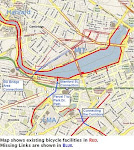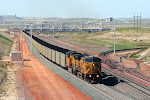 You may have heard or seen the recent commercials by the major railroad CSX:
You may have heard or seen the recent commercials by the major railroad CSX:- A gallon of fuel moves 1 ton of freight 423 miles
- One train takes the average of 286 trucks off the highways
Finally, there is a railroad is touting the benefits that come with operating at a lower coefficient of friction. Steel wheels on steel rails translate into less fuel needed.
While I've known the many benefits of rail over trucking, it has never been advertised to the general public. Likely, because the public has little interest or concern for railroads, except when they are held up at a grade crossing.
But now CSX believes there is a reason to sell this to the public. And they are hitting the major talking points. In esseence, using less fuel used translates into benefits that both conservatives and liberals can appreciate.
First, the economic benefit: less fuel used saves money. This is something even trucking companies realized in the ‘80s and ‘90s when they employed railroads for cross-country shipping of containers and trailers. Business and the economy in general benefit from lower shipping costs.
 Second, less fuel used means less pollution including less greenhouse gas emissions. CSX is touting how shipping by rail is “greener” than trucking. And with new improvements in locomotive fuel efficiency, including Prius-like locomotives, rail is becoming even more environmentally friendly.
Second, less fuel used means less pollution including less greenhouse gas emissions. CSX is touting how shipping by rail is “greener” than trucking. And with new improvements in locomotive fuel efficiency, including Prius-like locomotives, rail is becoming even more environmentally friendly. Third, when freight moves from highways to rail, it reduces highway traffic (something CSX promotes in one of its commercials). Instead of trucks pounding the payments and
 bridges built and maintained by gas tax dollars, rail freight runs on privately maintained infrastructure by companies that pay taxes. Why aren't the free-market conservatives all over this one? Shift freight to rail and reduce taxes while promoting business and increasing tax revenues!
bridges built and maintained by gas tax dollars, rail freight runs on privately maintained infrastructure by companies that pay taxes. Why aren't the free-market conservatives all over this one? Shift freight to rail and reduce taxes while promoting business and increasing tax revenues!Fourth, less use of fossil fuels reduces dependence on foreign oil.
The concept is simple: operating at a lower coefficient of friction, rail freight uses less fuel and produces less emissions.
Postscript: Now, while CSX is spreading the word, no one should believe they are the epitome of sustainability and environmental protection. Any railroad is an industrial operation that produces a number of hazardous materials from the preservative in wood ties to leaky fuel tanks and spills of petroleum products. Still, by advertising a commitment to sustainability and environmental protection, CSX and other railroads are cleaning up the operations.





 As reported by
As reported by 


